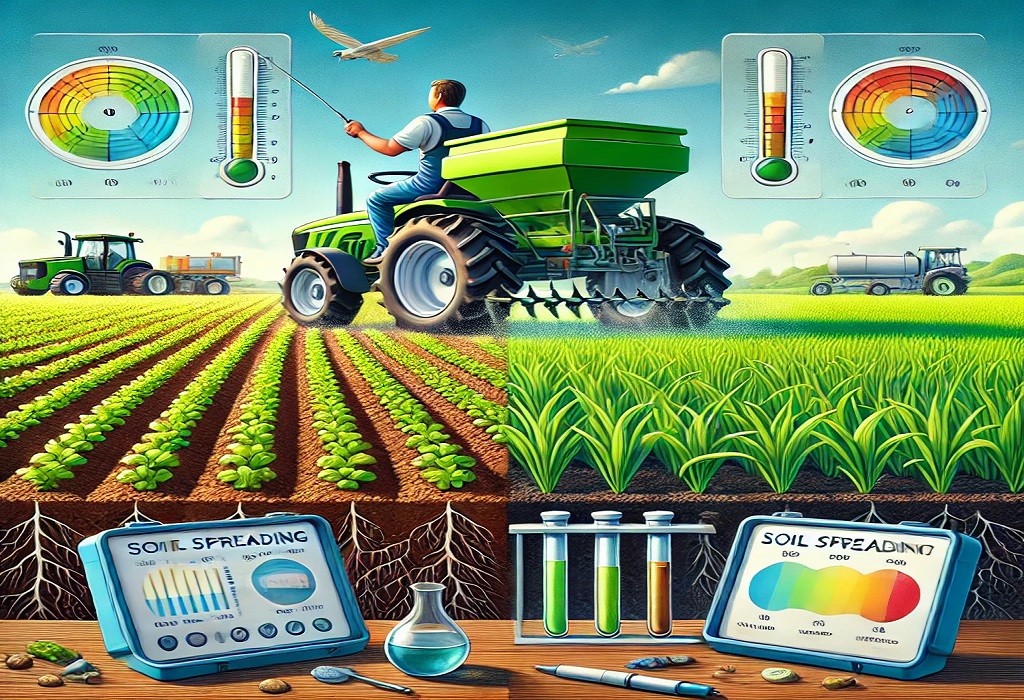Table of Contents
ToggleWhy Effective Fertilizer Application Matters
- Improves Crop Productivity: Supplies essential nutrients to plants.
- Reduces Waste: Ensures nutrients are absorbed, not lost.
- Minimizes Environmental Impact: Prevents leaching and runoff into water systems.
Types of Fertilizers and Their Applications
1. Granular Fertilizers
Granular fertilizers are easy to store and apply. They release nutrients slowly, making them ideal for crops with long growing seasons.
Application Tips:
- Use a broadcast spreader for even distribution.
- Apply during calm weather to avoid drift.
2. Liquid Fertilizers
Liquid fertilizers are absorbed quickly by plants, making them perfect for nutrient deficiencies or fast-growing crops.
Application Tips:
- Use sprayers for precise targeting.
- Dilute according to the manufacturer’s instructions.
3. Organic Fertilizers
Derived from natural sources, organic fertilizers improve soil health over time.
Application Tips:
- Incorporate into soil before planting.
- Use for crops requiring long-term soil enrichment.
Steps for Effective Fertilizer Application
1. Soil Testing
Before applying any fertilizer, test your soil to determine its nutrient needs.
- Identify deficiencies in nitrogen, phosphorus, or potassium (NPK).
- Adjust fertilizer type and amount accordingly.
2. Choose the Right Fertilizer
Based on your soil test results, select a fertilizer that meets your crop’s specific needs.
3. Timing is Key
- Before Planting: Apply fertilizers to prepare the soil.
- During Growth: Use side-dressing for additional nutrients.
- Post-Harvest: Enrich the soil for the next planting season.
4. Use Proper Application Techniques
- Broadcasting: Spreading fertilizer evenly across the field.
- Banding: Placing fertilizer in a strip beside the seeds.
- Foliar Feeding: Spraying liquid fertilizers on plant leaves.
5. Avoid Over-Fertilizing
Over-fertilization can damage plants and cause environmental harm. Follow recommended application rates.
Tools for Fertilizer Application
1. Spreaders
- Drop Spreaders: For precise application in small areas.
- Broadcast Spreaders: For large fields.
2. Sprayers
Ideal for liquid fertilizers, ensuring even distribution on crops.
3. Drip Irrigation Systems
Deliver liquid fertilizers directly to plant roots, conserving water and nutrients.
Common Mistakes to Avoid
- Applying fertilizer without a soil test.
- Using the wrong type of fertilizer for your crops.
- Applying during heavy rain, which can lead to nutrient runoff.
Environmental Considerations
1. Preventing Runoff
- Apply fertilizers during dry weather.
- Use buffer zones near water bodies.
2. Using Sustainable Practices
- Opt for slow-release or organic fertilizers.
- Combine fertilizers with crop rotation and cover crops.
Effective fertilizer application is crucial for maximizing crop yields, preserving soil health, and minimizing environmental impact. By following best practices—such as soil testing, proper timing, and the right tools—you can ensure optimal results for your crops.
With sustainable methods and attention to detail, you can make fertilizer application both productive and environmentally friendly, paving the way for long-term agricultural success.
